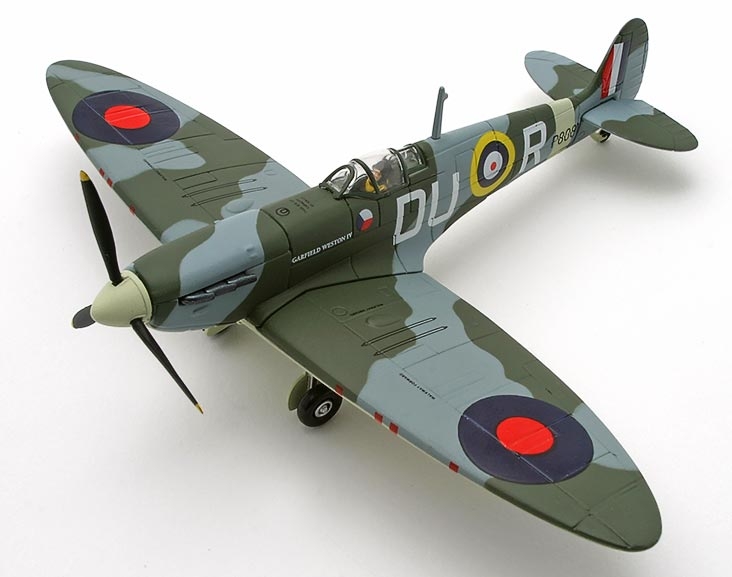Supermarine Spitfire Mk11 – Garfield Weston, 312 Sqn RAF, Tomas Vybiral 1941
Add to compare1 in stock
£39.99
1 in stock
Corgi Aviation Archive 1/72 scale 49003: Spitfire Mk11 P8081 (named “Garfield Weston” after the village which paid for it) was the personal mount of Czech ace Tomas Adolphe Vybiral, 312 “Czech” Squadron RAF in 1941. Finished in the grey and green camouflage scheme adopted in the early 1940s, this highly accurate scale replica model is one of the fantastic “Flying aces” series released by Corgi in 2000.
Length 5 inches Wingspan 6,25 inches
PLEASE NOTE: Boxes are not perfect with the odd crush or scuff. Models are new
Tomas Adolphe Vybiral was born in 1911 and was serving in the Czech Air Force in the thirties. The Germans took over Czechoslovakia on March 15th 1939 and Vybiral subsequently escaped to France. Like other Czechs, he joined the Foreign Legion, the only unit open to foreigners.
After the outbreak of war, Vybiral was seconded to the Armee de l’Air. He served as a Lieutenant in Groupe de Chasse I/5, flying the Curtiss 75A Hawk fighter. On May 13th 1940 he shared in destroying a He111, on the 15th shared a Hs126, on the 16th shared another Hs126 and a Do17, shared He111’s on June 1st and 5th and destroyed a Me110 on June 10th. When France capitulated, Vybiral made his way to England having scored 7 victories.
He joined the RAF and, after converting to Hurricanes, was posted to 312 Squadron at Duxford on September 5th 1940. On a flight from Speke on October 15th Vybiral lost his bearings and having run low on fuel, he baled out over Dalton-in-Furness. His Hurricane, V6811, crashed at Gleaston.
In early 1942 Vybiral was posted to 41 Squadron as a Flight Commander. He shared in the destruction of a Fw190 on May 4th. From January to November 1943 he commanded 312 Squadron. During 1944 Vybiral led the Czech Wing from North Weald. He was awarded the DFC (gazetted 11th July 1944) and the DSO in December 1944. As well as holding Czechoslovak war decorations, Vybiral was a Companion of the Legion d’Honneur.
In August 1945 he returned to Czechoslovakia but after the Communist coup in 1948 he escaped with his family to England and died there on 21st February 1981, being buried at Brookwood with his wartime Czech comrades.
The Supermarine Spitfire is a British single-seat fighter aircraft that was used by the Royal Air Force and many other Allied countries throughout the Second World War. The Spitfire continued to be used as a front line fighter and in secondary roles into the 1950s. It was produced in greater numbers than any other British aircraft and was the only British fighter in production throughout the war. The Spitfire was designed as a short-range, high-performance interceptor aircraft by R. J. Mitchell, chief designer at Supermarine Aviation Works (since 1928 a subsidiary of Vickers-Armstrong). Mitchell continued to refine the design until his death from cancer in 1937, whereupon his colleague Joseph Smith became chief designer. The Spitfire’s elliptical wing had a thin cross-section, allowing a higher top speed than several contemporary fighters, including the Hawker Hurricane. Speed was seen as essential to carry out the mission of home defence against enemy bombers. During the Battle of Britain, the Spitfire was perceived by the public as the RAF fighter of the battle, whereas in fact, the more numerous Hurricane actually shouldered a greater proportion of the burden against the Luftwaffe. The Spitfire units did, however, have a lower attrition rate and a higher victory to loss ratio than those flying Hurricanes. After the Battle of Britain, the Spitfire became the backbone of RAF Fighter Command, and saw action in the European, Mediterranean, Pacific and the South-East Asian theatres. Much loved by its pilots, the Spitfire served in several roles, including interceptor, photo-reconnaissance, fighter-bomber, carrier-based fighter, and trainer. It was built in many variants, using several wing configurations. Although the original airframe was designed to be powered by a Rolls-Royce Merlin engine producing 1,030 hp, it was adaptable enough to use increasingly more powerful Merlin and the later Rolls-Royce Griffon engines; the latter was eventually able to produce 2,035 hp
| Weight | 0.8 kg |
|---|

